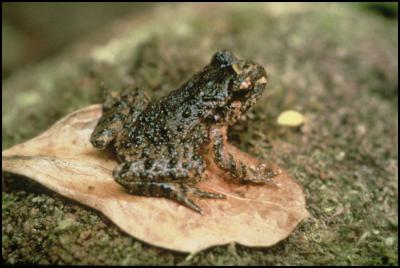Tiny native frog wins big victory today
Tiny native frog wins big victory today

The accidental discovery twenty-four years ago of a tiny native frog near Te Puke lead to a long-running conservation battle which finally paid off today.
The habitat of the rare frog is today officially classed as conservation sanctuary, allowing it to be protected and giving the rare local Hochstetter’s frogs a chance at long-term survival.
The small, 400-hectare area of land has been the subject of much local debate over the past 20 years. The first frog in the Otawa block was discovered by a volunteer on a Forest & Bird walk, but the organisation was later accused of deliberately putting it there.
The area was quarried from the 1960s, which posed a major threat to the habitat. The frogs' chief champions, the local Forest & Bird branches, were blockaded and accused of trespassing by the quarry owner. Al Fleming, Forest & Bird’s Central North Island Conservation Manager, had the air in his vehicle’s tyres released on one visit.
Mr Fleming says “Members from both Te Puke and Tauranga have fought tenaciously for the welfare of this rare and beautiful frog. Without their combined efforts, the Otawa frog population could have been destroyed by the quarry owner years ago.”
Hochstetter's frogs are as unique to New Zealand as our iconic kiwi and kakapo. They belong to an ancient genus called Leiopelma, which split off from other frog species around the time of the dinosaurs. They exhibit many strange and primitive traits such as being voiceless, lacking external ears, and hatching as tiny froglets instead of tadpoles.
Hochstetter's frogs are divided into 19 genetically distinct populations. The Otawa population is believed to be the smallest, at about 200 individuals, and has been identified as nationally critical – one step away from extinction.
The quarrying ceased in 2009 but the land is still unstable and human disturbance is an issue. The tiny frogs can easily be crushed by walkers, horses or passing vehicles. Despite all these hardships the population of frogs has persisted.
“The frogs now have a chance and the new Sanctuary land status give DOC and the community an opportunity to restore the frogs’ habitat, protect them from predators, and ensure that the frogs’ recovery and protection is a priority.” Mr Fleming says.
“This is a story of persistence and determination. These special animals have been around for a very long time, and Forest & Bird members are proud to have played a role in guaranteeing them a future.”


 Gordon Campbell: On What’s Wrong With The Treaty Principles Bill
Gordon Campbell: On What’s Wrong With The Treaty Principles Bill Te Pāti Māori: Government’s First Year A ‘Catastrophe For Māori’
Te Pāti Māori: Government’s First Year A ‘Catastrophe For Māori’ Department Of Internal Affairs: Samoan Citizenship Bill Passes Into Law
Department Of Internal Affairs: Samoan Citizenship Bill Passes Into Law NZ National Party: National Acknowledges The Passing Of Hon Nikki Kaye
NZ National Party: National Acknowledges The Passing Of Hon Nikki Kaye Mana Mokopuna: Children And Young People Share Vital Insights On Healing From Family Violence And Sexual Violence In New Report
Mana Mokopuna: Children And Young People Share Vital Insights On Healing From Family Violence And Sexual Violence In New Report NZ Government: PM Marks One Year In Government
NZ Government: PM Marks One Year In Government Helen Clark Foundation: Helen Clark Foundation Calls For Political Action To Reduce The Prevalence Of Junk Food And Improve Health Outcomes
Helen Clark Foundation: Helen Clark Foundation Calls For Political Action To Reduce The Prevalence Of Junk Food And Improve Health Outcomes


